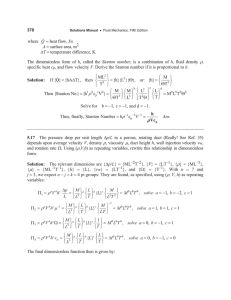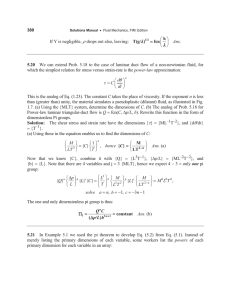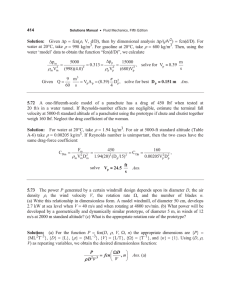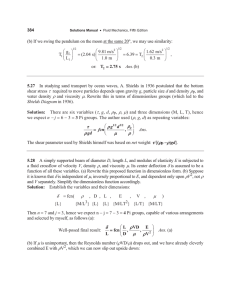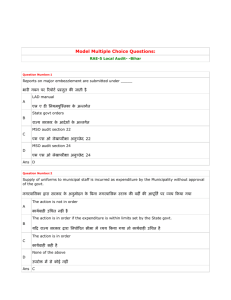P5.39 Consider natural convection in a rotating, fluid
advertisement
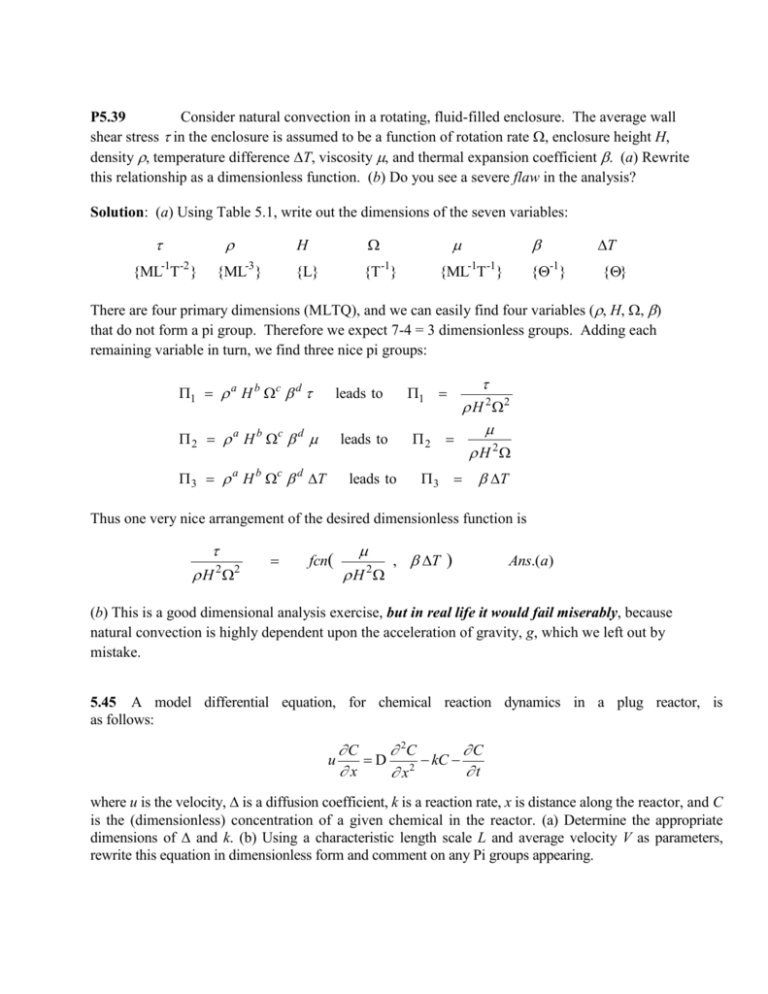
P5.39
Consider natural convection in a rotating, fluid-filled enclosure. The average wall
shear stress in the enclosure is assumed to be a function of rotation rate , enclosure height H,
density , temperature difference T, viscosity , and thermal expansion coefficient . (a) Rewrite
this relationship as a dimensionless function. (b) Do you see a severe flaw in the analysis?
Solution: (a) Using Table 5.1, write out the dimensions of the seven variables:
{ML-1T-2 }
{ML-3 }
H
{L}
{T-1}
{-1}
{ML-1T-1}
T
{}
There are four primary dimensions (MLTQ), and we can easily find four variables (, H, , )
that do not form a pi group. Therefore we expect 7-4 = 3 dimensionless groups. Adding each
remaining variable in turn, we find three nice pi groups:
1 a H b c d
1
leads to
2 a H b c d
2
leads to
3 a H b c d T
leads to
H 2 2
H 2
3
T
Thus one very nice arrangement of the desired dimensionless function is
H 2 2
fcn(
H 2
, T )
Ans.(a)
(b) This is a good dimensional analysis exercise, but in real life it would fail miserably, because
natural convection is highly dependent upon the acceleration of gravity, g, which we left out by
mistake.
5.45 A model differential equation, for chemical reaction dynamics in a plug reactor, is
as follows:
u
C
2C
C
D
kC
2
x
t
x
where u is the velocity, is a diffusion coefficient, k is a reaction rate, x is distance along the reactor, and C
is the (dimensionless) concentration of a given chemical in the reactor. (a) Determine the appropriate
dimensions of and k. (b) Using a characteristic length scale L and average velocity V as parameters,
rewrite this equation in dimensionless form and comment on any Pi groups appearing.
Solution: (a) Since all terms in the equation contain C, we establish the dimensions of k and by
comparing {k} and {2/ x2} to {u/ x}:
2
1
L 1
{k} {D} 2 {D} 2 {u} ,
L
x T L
x
L2
1
hence { k} and {D } Ans. (a)
T
T
(b) To non-dimensionalize the equation, define u* u/V , t* Vt /L, and x* x/L and substitute into the
basic partial differential equation. The dimensionless result is
C D 2 C kL
C
VL
u*
C
, where
mass-transfer Peclet number Ans. (b)
2
x* VL x* V
t*
D
5.71 The pressure drop in a venturi meter (Fig. P3.128) varies only with the fluid density, pipe approach
velocity, and diameter ratio of the meter. A model venturi meter tested in water at 20C shows a 5-kPa drop
when the approach velocity is 4 m/s. A geometrically similar prototype meter is used to measure gasoline at
20C and a flow rate of 9 m3/min. If the prototype pressure gage is most accurate at 15 kPa, what should
the upstream pipe diameter be?
Solution: Given p fcn(, V, d/D), then by dimensional analysis p/(V2) fcn(d/D). For water at
20C, take 998 kg/m3. For gasoline at 20C, take 680 kg/m3. Then, using the water ‘model’ data to
obtain the function “fcn(d/D)”, we calculate
pp
pm
5000
15000
m
0.313
, solve for Vp 8.39
2
2
2
2
s
m Vm (998)(4.0)
p Vp (680)Vp
9 m3
Given Q
Vp A p (8.39) D2p , solve for best D p 0.151 m
60 s
Ans.
5.79 An East Coast estuary has a tidal period of 12.42 h (the semidiurnal lunar tide) and tidal
currents of approximately 80 cm/s. If a one-five-hundredth-scale model is constructed with tides
driven by a pump and storage apparatus, what should the period of the model tides be and what
model current speeds are expected?
Solution:
Given Tp 12.42 hr, Vp 80 cm/s, and Lm/Lp 1/500. Then:
Froude scaling: Tm Tp
Vm Vp 80
12.42
0.555 hr 33 min Ans. (a)
500
(500) 3.6 cm/s Ans. (b)
5.83 A one-fortieth-scale model of a ship’s propeller is tested in a tow tank at 1200 r/min and
exhibits a power output of 1.4 ft·lbf/s. According to Froude scaling laws, what should the
revolutions per minute and horsepower output of the prototype propeller be under dynamically
similar conditions?
Solution:
Given 1/40, use Froude scaling laws:
p /m Tm /Tp thus p
3
1200
rev
190
1/2
min
(40)
Ans. (a)
5
3
p p Dp
1
5
Pp Pm
(1.4)(1)
(40)
D
40
m m m
567000 550 1030 hp Ans. (b)
C5.5 Does an automobile radio antenna vibrate in resonance due to vortex shedding? Consider an
antenna of length L and diameter D. According to beam-vibration theory [e.g. Kelly [34], p. 401], the
first mode natural frequency of a solid circular cantilever beam is n 3.516[EI/(AL4)]1/2, where E is
the modulus of elasticity, I is the area moment of inertia, is the beam material density, and A is the
beam cross-section area. (a) Show that n is proportional to the antenna radius R. (b) If the antenna is
steel, with L 60 cm and D 4 mm, estimate the natural vibration frequency, in Hz. (c) Compare with
the shedding frequency if the car moves at 65 mi/h.
Solution: (a) From Fig. 2.13 for a circular cross-section, A R2 and I R4/4. Then the natural
frequency is predicted to be:
n 3.516
E R 4 /4
E R
1.758
Const RP
2 4
L2
R L
Ans. (a)
(b) For steel, E 2.1E11 Pa and 7840 kg/m3. If L 60 cm and D 4 mm, then
n 1.758
2.1E11 0.002
rad
51
8 Hz
2
7840 0.6
s
Ans. (b)
(c) For U 65 mi/h 29.1 m/s and sea-level air, check ReD UD/ 1.2(29.1)(0.004)/ (0.000018)
7800. From Fig. 5.2b, read Strouhal number St 0.21. Then,
shed D shed (0.004)
rad
0.21, or: shed 9600
1500 Hz Ans. (c)
2 U
2 (29.1)
s
Thus, for a typical antenna, the shedding frequency is far higher than the natural vibration frequency.

